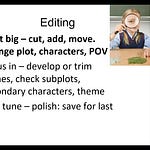Transcript: Hi and welcome back to Write Better Right Now. Today I’m starting a series on editing.
One of the challenges of editing is to step back from your work and look at the big picture. It's relatively easy to go through a page of text and find words to tweak, but you don't really want to start that way.
You want to start by looking at the whole story. Is there anything that you need to change with the plot – write new scenes, delete some chapters, change what happens in the story? Are there characters that should be changed or secondary characters that can be combined? Do you need more or fewer characters?
You might even decide that you wrote it in third person point of view and it would be better in first person, or you have multiple viewpoint characters and maybe it should be only one, or the other way around. There's no single right answer, which is why you need to take time to look at those questions. You should also be thinking about cutting, adding, and moving anything when you're looking at the big picture, before you start to focus in, trimming scenes, checking subplots, and so forth, and certainly before you fine tune.
We'll be going through each of those stages, but starting big is so important that I have multiple videos on just that aspect.
It's helpful to find a way to look at the story as a whole to go back and remind yourself of what your goal was when you started. I developed something that works for me, the plot arc exercise, which is in my book, Advanced Plotting.
The first step is to define your goal. You might be trying to write a heartwarming romance or an action-packed suspense, maybe something as specific as a goofy humor novel that will appeal to reluctant reader preteen boys. It can be the kind of categories you might have on Amazon or where your book would be shelved in a bookstore, or it can be a more specific audience.
So think about who you're trying to reach with your book.
From there, you can write an elevator pitch, so-called because it's a sentence or two that very quickly conveys the idea of your story, should you be in an elevator with an editor. We're not writing this for an editor. It may be something you could use in the future in a query letter or to pitch your work to an audience on social media once it's published. But right now, this is just for your own use. So don't worry about getting it perfect. It's just the whole story condensed down into a way that you can remind yourself of what you were trying to achieve.
As an example, Whispers in the Dark is romantic suspense. That's the genre category. That's where it would be shelved in the bookstore. That's the sort of top-level category on Amazon or other online bookstores.
• A young archaeologist stumbles into danger as mysteries unfold among ancient Southwest ruins. Can she overcome the fears from her past, learn to fight back, and open herself to a new romance?
• Look for keywords that define the goal: mystery, suspense, romance
I've bolded the keywords, which relate to mystery, suspense, romance. That's what I want to give readers, that experience of having an exciting story with a nice romance. Yes, the ancient Southwest ruins are key to this as well. The setting is a very big part of the story. But I'm not writing a nonfiction about the Southwest ruins. I'm writing a romantic suspense. This helps me remember of what my focus is for the book.
The next example is for a middle grade novel. The Eyes of Pharaoh is a mystery novel set in ancient Egypt.
• When their best friend disappears, Seshta and Horus spy on merchants, soldiers, and royalty, and fall into a dangerous trap as they uncover a plot against Egypt.
• Define goals: mystery, danger
Listen to this episode with a 7-day free trial
Subscribe to Write Better Right Now Substack to listen to this post and get 7 days of free access to the full post archives.









